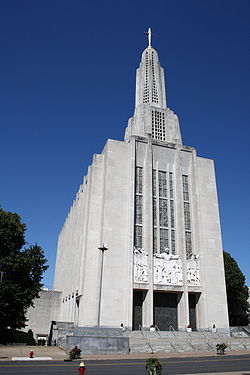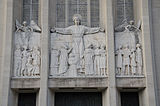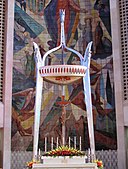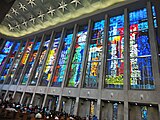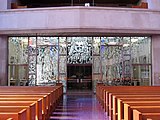
St. Patrick's Cathedral is a Catholic cathedral in the Midtown Manhattan neighborhood of New York City. It is the seat of the Archbishop of New York as well as a parish church. The cathedral occupies a city block bounded by Fifth Avenue, Madison Avenue, 50th Street, and 51st Street, directly across from Rockefeller Center. Designed by James Renwick Jr., it is the largest Gothic Revival Catholic cathedral in North America.

Michael Joseph McGivney was an American Catholic priest based in New Haven, Connecticut. He founded the Knights of Columbus at a local parish to serve as a mutual aid and insurance organization, particularly for immigrants and their families. It developed through the 20th century as the world's largest Catholic fraternal organization.

St. Raphael's Cathedral is a Catholic cathedral and a parish church in the Archdiocese of Dubuque located in Dubuque, Iowa. The parish is the oldest congregation of any Christian denomination in the state of Iowa. The cathedral church, rectory, former convent, and former parochial school building are contributing properties in the Cathedral Historic District on the National Register of Historic Places.

The Cathedral of Saint Paul is a Roman Catholic cathedral in the city of Saint Paul, Minnesota. It is the co-cathedral of the Archdiocese of Saint Paul and Minneapolis, along with the Basilica of Saint Mary in Minneapolis. One of the most distinctive cathedrals in the United States, it sits on Cathedral Hill overlooking downtown Saint Paul and features a distinctive copper-clad dome. It is dedicated to Paul the Apostle, who is also the namesake of the City of Saint Paul. The current building opened in 1915 as the fourth cathedral of the archdiocese to bear this name. On March 25, 2009, it was designated as the National Shrine of the Apostle Paul by the United States Conference of Catholic Bishops. It is the third-largest Catholic cathedral and sixth-largest church in the United States.
The Cathedral of the Good Shepherd is the oldest Catholic church in Singapore, built in 1847. It is located in the Museum Planning Area within the Civic District.

The Basilica-Cathedral of St. John the Baptist in St. John's, Newfoundland and Labrador is the metropolitan cathedral of the Roman Catholic Archdiocese of St. John's, Newfoundland and the mother church and symbol of Roman Catholicism in Newfoundland. The building sits within the St. John's Ecclesiastical District, a National Historic District of Canada.

St. Augustine Cathedral, located in Bridgeport, Connecticut, United States, is the seat of the Roman Catholic Diocese of Bridgeport.

The Archdiocese of Hartford is a Latin Church ecclesiastical territory or archdiocese of the Catholic Church in Connecticut in the United States. It is a metropolitan see.

The Metropolitan Cathedral Church of the Holy Cross, Our Lady of Regla, and St Francis of Assisi is the main ecclesiastical building of the Catholic Church in Chihuahua City, Chihuahua, Mexico. It is considered perhaps the finest example of colonial architecture in northern Mexico and it was built between 1725 and 1792. The cathedral is also the seat of the Roman Catholic Archdiocese of Chihuahua. As of 2013 the archbishop was Constancio Miranda Weckmann.

The Cathedral of St. John the Baptist is the mother church of the Roman Catholic Diocese of Charleston, located in Charleston, South Carolina. Designed by Brooklyn architect Patrick Keely in the Gothic Revival style, it opened in 1907. The Most Reverend Jacques E. Fabre, the fourteenth Bishop of Charleston, was ordained and installed on May 13, 2022

St. Mary Church is a Roman Catholic church in New Haven, Connecticut, part of the Archdiocese of Hartford. It is the seat of the city-wide Blessed Michael McGivney Parish. As of July 1, 2023, the consolidated city-wide parish operates eight churches for regularly scheduled worship.

St. Peter's Cathedral Basilica, is a church located at 196 Dufferin Avenue in London, Ontario, Canada in the Roman Catholic Diocese of London.

The Cathedral Basilica of Christ the King is a Roman Catholic church in Hamilton, Ontario, Canada. The cathedral was consecrated on December 19, 1933. It is the seat of the bishop of the Diocese of Hamilton, and the cathedral of the Diocese of Hamilton. The cathedral contains the cathedra of the bishop, the Most Rev. Douglas Crosby. The cathedral was raised to the status of a minor basilica in February 2013 by Pope Benedict XVI.

The Cathedral of St. John the Evangelist is a historic Roman Catholic church building located at 1007 Superior Avenue in Cleveland, Ohio, in the United States. Completed and consecrated in 1852, it is the cathedral of the Roman Catholic Diocese of Cleveland. Numerous renovations have enlarged and changed some aspects of the cathedral, but it remains essentially the same since its construction.

Francis Patrick McFarland was an American Catholic bishop who served as the third Bishop of Hartford.

The Basilica of the Immaculate Conception is a Roman Catholic church located at 74 West Main Street in Waterbury, Connecticut.

Saints Peter and Paul Cathedral is a Roman Catholic cathedral located at Fourteenth and Meridian Streets in Indianapolis, Indiana, United States. It is the seat of the Archdiocese of Indianapolis, and of the Archbishop of Indianapolis, most recently Archbishop Charles C. Thompson. Silas Chatard, the first Bishop of Indianapolis, established the cathedral parish in 1892, and named it after Saint Peter and Saint Paul, two apostles of Christ. The cathedral parish became known for its liturgical celebrations and sacred music performances.
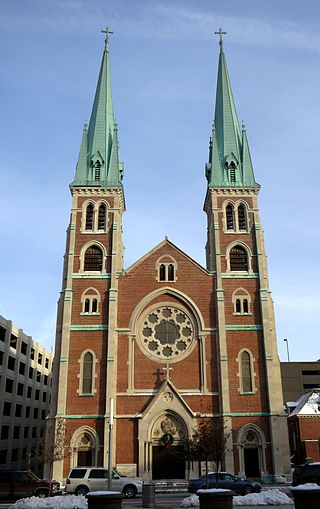
Saint John the Evangelist Catholic Church is a Roman Catholic parish of the Archdiocese of Indianapolis in Indianapolis, Indiana, United States. The parish's origins date to 1837, when it was first named Holy Cross parish. In 1850 it was renamed Saint John the Evangelist parish, and is the oldest Catholic parish in the city and in Marion County, Indiana. Considered the mother of the Catholic parishes in Indianapolis, it played an important role in development of the Catholic Church in the city. Saint John's Church served as the pro-cathedral of the diocese from 1878 until 1906; its rectory served as the bishop's residence and chancery from 1878 until 1892. In 1900 the church served as the site of first episcopal consecration held in Indianapolis.
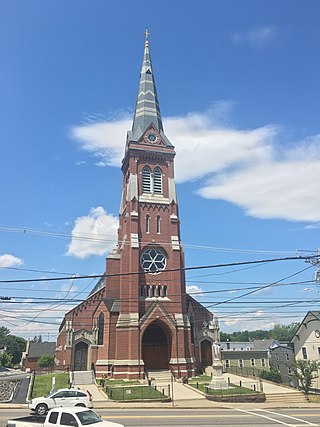
Saint Joseph's Church is one of the 5 churches of Good Shepherd Parish located at 178 Elm Street in Biddeford, Maine.
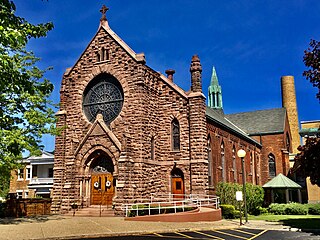
Blessed Sacrament Church is a historic Roman Catholic church in Buffalo, New York, United States. Constructed in the late 19th century, it remains the home of an active congregation and has been recognized as a historically significant building in the Linwood Historic District of Buffalo.
